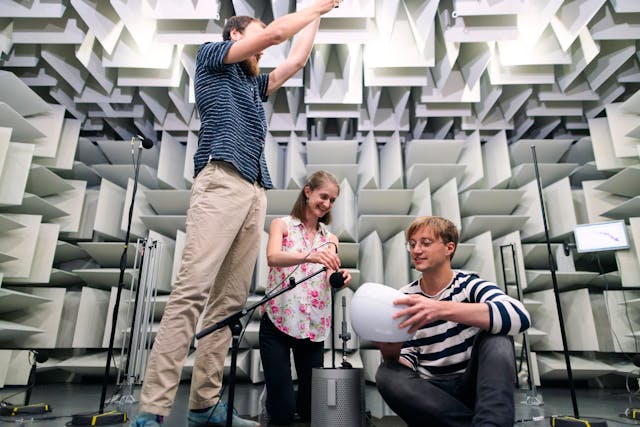
How do you soundproof a room? There are several ways, but the basic way of soundproofing a room is to make sure that there are no gaps in the walls or door and cover all surfaces in a material that absorbs sound.
Sound is caused when energy is transmitted through something in a wave. When your speakers make sound, the music you are listening to has been translated into electrical signals that make the speakers vibrate. Those vibrations push the air molecules next to them, which push the molecules next to them, and so on. The initial energy determines how far the sound wave will go because with each interaction, some of the energy is converted to heat. To soundproof a room, you have to find a way to stop that energy getting through the walls.
There are many ways to stop a sound wave travelling through a material. One way is to use a very dense material that is lossy. If a material is very dense, the atoms are close together and you have far more atoms to volume than if a material is less dense. This leads to two different properties, one of which is good for sound proofing and one that isn’t. Materials like water and steel are very dense. They have a lot of molecules close together. When sound enters them, it is very easy for the sound to transfer to the next molecule and sound travels very far and very fast in both of these mediums. They would not be good for soundproofing. Then there are materials like concrete. They are also dense with a lot of molecules per volume, but they are lossy. Lossy means the molecules can’t vibrate very much and energy is dissipated within them. When sound enters concrete or brick, the energy is very quickly dissipated and the soundwave stops. Dense materials like concrete are very good at stopping sound passing through them, but they also reflect a lot of the sound back. That is why you get a lot of echo in a bare concrete room.
Another way of absorbing sound is to use foam padding over the walls. There are two types of foam used to soundproof a room: open cell and closed cell. Open cell foam is like a sponge, with lots of open and interconnected openings. Closed cell foam is full of sealed bubbles. Closed cell foam blocks sound in the same way as concrete. It is dense and it absorbs the sound. It’s advantage is it is lighter than concrete. Open cell foam has lots of tiny pathways that the air with the sound can get through. But every time they go through a narrow passageway, they molecules are squeezed together and they interact with each other and with the molecules in the foam. Each time they do, there is friction, and some of the sound energy is converted to heat. Any of these methods can be used to make a room soundproof.
There is one room I have seen in the news that is completely silent both inside and outside. We are looking at how to stop sound penetrating the walls, but this room has stopped all sound. These rooms are called anechoic chambers and there is no sound. In fact, they are so quiet that they are measured in negative decibels. There is absolutely no background noise, which means if you go in the room, the only things you can hear are the sounds inside your body. People say that they can hear their blood pumping and the sound of their eyelids when they blink.
The room starts with a concrete box, with walls that are 30 cm thick, which absorbs sound, as we have learned. Then there is a space and another box made of steel suspended on strings. Inside this box is a space and then another box suspended on springs. This box is the chamber. The spaces between the surfaces help insulate it from sound. Then the walls inside that chamber are covered in wedge shaped fiberglass. Fiberglass is rigid, but it has the same open cell shape we talked about earlier. The sound gets trapped inside and gets squeezed until it is all lost to heat. The fiberglass pieces are wedge shaped so that any sound that reflects back hits other fiberglass panels and all of the sound is absorbed. Apparently, people who go into an anechoic chamber get very disorientated and even have trouble balancing. We are constantly exposed to sound and we use it to work out our position. And this is what I learned today.
Sources
https://www.acousticalsurfaces.com/blog/acoustics-education/soundproof-room
https://en.wikipedia.org/wiki/Soundproofing
https://www.acoustiblok.co.uk/soundproofing-materials
https://www.smithsonianmag.com/smart-news/earths-quietest-room-you-can-hear-yourself-blink-180948160
Photo by ThisIsEngineering: https://www.pexels.com/photo/engineers-in-sound-studio-3861941/
